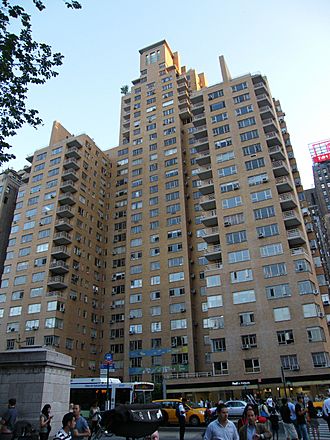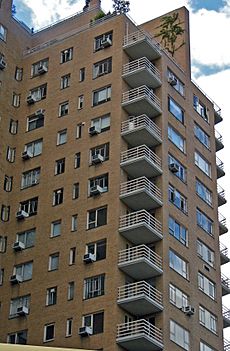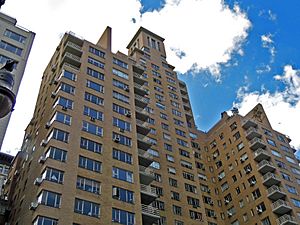240 Central Park South facts for kids
Quick facts for kids 240 Central Park South |
|
|---|---|
 |
|
| General information | |
| Type | Residential and commercial |
| Architectural style | Art Deco, Moderne |
| Address | 240 Central Park South, New York, NY 10019 |
| Coordinates | 40°46′02″N 73°58′52″W / 40.76722°N 73.98111°W |
| Construction started | 1939 |
| Completed | September 1940 |
| Cost | $34 million |
| Height | 265 feet (81 m) |
| Technical details | |
| Structural system | Steel |
| Floor count | 28 |
| Floor area | 387,428 square feet (35,993 m2) |
| Lifts/elevators | 6 |
| Grounds | 36,475 square feet (3,389 m2; 0 ha) |
| Design and construction | |
| Architect | Albert Mayer and Julian Whittlesey |
| Developer | Mayer family |
| Main contractor | J.H. Taylor Construction Company |
|
240 Central Park South
|
|
| Location | 240 Central Park S., Manhattan, New York |
| Built | 1940 |
| Architect | Albert Mayer and Julian Whittlesey |
| Architectural style | Art Deco, Moderne |
| NRHP reference No. | 09000304 |
| Significant dates | |
| Added to NRHP | May 12, 2009 |
240 Central Park South is a large apartment building in Midtown Manhattan, New York City. It was designed by Albert Mayer and Julian Whittlesey. The building was constructed between 1939 and 1940. It was built by the J.H. Taylor Construction Company, which was owned by the Mayer family.
This building combines two styles: Art Deco and Moderne. It has over 300 apartments. 240 Central Park South faces Central Park to the north. It is also near Columbus Circle and Broadway to the west. To the south, it faces 58th Street.
The building covers about half of its one-acre land. It is shaped like a "C". It has a 20-story section facing Central Park South. On top of this section is an 8-story tower. There is also a 15-story section along 58th Street. A lobby on the ground floor connects these two parts. The outside of the building is made of orange brick. Some apartments have balconies that stick out. The building also has a famous restaurant called Marea. It features open spaces like a courtyard and rooftop terraces. A beautiful mosaic by Amédée Ozenfant is above the main entrance.
When it was finished, 240 Central Park South was one of Manhattan's biggest apartment buildings. It was promoted as a great place to live, offering a different option from the growing suburbs. Many people praised its design, including writer Lewis Mumford. The building became a city landmark in 2002. It was added to the National Register of Historic Places in 2009.
Location and Surroundings
240 Central Park South is located in the Midtown Manhattan area of New York City. It sits on the southeast side of Columbus Circle. The building has a long side facing Central Park South. It also has a side along Broadway and another along 58th Street. The total area of the land is about 36,475 square feet.
Nearby buildings include Gainsborough Studios and 220 Central Park South to the east. Central Park is just across Central Park South. Across 58th Street are Central Park Tower and 1790 Broadway. You can find entrances to the New York City Subway's 59th Street–Columbus Circle station right outside the building. This station serves many subway lines.
In the late 1800s and early 1900s, Central Park South became known as Manhattan's "Gold Coast." Many fancy hotels and apartment buildings were built there. The land where 240 Central Park South now stands was once owned by George Ehret. He was a brewer who owned a lot of land in New York City. He bought many small lots between 1881 and 1908. Ehret had planned to build a hotel on his land. By 1927, his lot was one of the last undeveloped spots on Broadway in that area. Later, a two-story building for the car industry was built on the site.
Building Design
240 Central Park South was designed by Mayer & Whittlesey. This was a team made up of Albert Mayer and Julian Whittlesey. Cynthia Wiley and Eleanor Robertson Paepcke helped design the outdoor areas. The J. H. Taylor Construction Company built the building. The J. H. Taylor Management Corporation managed it. Both companies were run by the Mayer family. Sarah Tobias, who rented out apartments, also helped with the inside design. Many different companies worked on the building. They handled things like windows, elevators, and heating systems.
Building Shape
240 Central Park South uses about half of its land. The building is mostly shaped like a "C". It has two main parts. One part is 28 stories tall and faces Central Park South. The other part is 15 stories tall and faces 58th Street. The lobby along Broadway connects these two parts. There are chimneys and water towers on top of the main roofs. The building has either 325, 326, or 327 apartments.
The northern part of the building, on Central Park South, is 265 feet tall. It has 28 stories. The first 20 stories rise straight up. They have balconies only at the corners. The middle section has a smaller 8-story tower on top of the 20th story. This northern part is "C"-shaped. It has two wings on the west and east sides. These wings create a small courtyard to the north.
The southern part of the building, on 235 West 58th Street, is 166 feet tall. It has 15 stories. This part rises straight up without any setbacks.
Outside Appearance
The outside of the building is made of orange bricks. The bricks have different shades of color. The windows usually have slate sills. The apartments have wide steel-framed windows that face the street. Some corner apartments have windows that stick out. These windows have one to three glass panes. Smaller windows were used where there were blocked views. Another type of window was wide with a high sill. These were used where fresh air was needed.
Ground Level Details
The main entrance is on Central Park South. It is in a small garden courtyard. You reach the entrance by a concrete sidewalk. This sidewalk has low walls on its sides. The entrance doors are under a canopy. They are inside a slightly curved area with brick walls and large windows. The right side of the courtyard has a gray-blue wall. This wall is made of square tiles by Atlantic Terra Cotta. It covers a small shop. On the northern wall, above the second and third floor windows, are two mosaic panels. These panels form a mural called "The Quiet City" by Amédée Ozenfant.
The second entrance is on 58th Street, near Broadway. It has double doors surrounded by Atlantic Terra Cotta blocks. There is also a plant box to the left of the entrance. A loading dock is on the far east side of 58th Street. This helps avoid traffic jams. The loading area has a ramp that goes down to the basement. The ramp is made of concrete and can fit two cars. There used to be plants on both sides of the ramp. A canopy covers the north side of the ramp.
There are ten shops on Broadway. The four shops in the middle have rounded corners. They are surrounded by three square shops on each side. The central shops on Broadway are set back in a zig-zag pattern. They have rounded windows. Mayer designed the rounded shops to make their display windows more valuable. He said they gave each shop "many of the advantages of a corner location." Architectural Forum magazine said in 1941 that the shops "permitted the enlargement of the normal sidewalk area."
Balconies
About 100 apartments have outdoor balconies. These balconies are about 8 by 8 feet in size. They stick out from the windows. The balconies are made of concrete slabs. Most still have their original metal railings.
In the northern part of the building, balconies are above the seventh floor on the side facing Central Park. On the south side, they are above the twelfth floor. The only exception is the northeast corner. There, balconies start above the 16th floor. The balconies facing the park were meant to give residents a view above the trees. This view was not possible below the seventh floor. The "tower" of the northern block also has balconies. These are on the 22nd through 26th floors at the northern corners. There is also a terrace on the 27th floor. In the southern part of the building, all balconies are above the 10th story.
Inside Features
The inside of 240 Central Park South has a steel frame. This frame was made by Bethlehem Steel. The building's columns rest on concrete foundations. The floors are made of concrete slabs. The total floor area of the building is about 387,428 square feet.
The building has its own power plant. It has steam boilers, a diesel engine, and two steam turbines. These can produce 625 kilowatts of power. It also has a hot water heating system. There are six elevators in the building. Four are for passengers and two are for moving goods. Four elevators serve the northern part of the building. The other two serve the southern part. The building was designed to be quiet. For example, some elevator parts were made of leather. Carpets were used in hallways to reduce noise. Bedrooms were placed away from elevator shafts.
Lobby
The lobby has entrances from both Central Park South and 58th Street. It is split into two parts, one near each entrance. The northern lobby leads to the four northern elevators. These elevators are on either side of the path to the southern lobby. The elevator areas are covered in marble. The northern lobby has green terrazzo floors. It also has copper-covered walls and hidden lights. There is a marble desk for mail. The copper walls and terrazzo floors continue into the path between the lobbies. A solarium, with marble walls and large windows, is next to this path. It faces an enclosed garden. The southern lobby leads to the two southern elevators.
The lobby also has doors to the shops facing Broadway and Columbus Circle. There is a restaurant space on the northeast corner of the building. This restaurant space is now home to Marea. Marea is a Michelin-starred Italian and seafood restaurant. The building plans also show rooms for maids and offices. These are located around the central courtyard and near the 58th Street entrance.
Gardens and Green Spaces
240 Central Park South has several outdoor areas. These include the small courtyard at the main entrance. There are also plants along 58th Street. An enclosed garden is on the ground level. There are also rooftop gardens and terraces on different parts of the building. The ground-level garden had crabapples, magnolia, and white birch trees. Boston ivy grew on its walls. On the roof of the lobby, between the two apartment parts, there was a garden. This garden had willows, forsythia, rhododendrons, and grass with flower beds. The roof of the enclosed garden curves above the lobby roof. The roof of the 58th Street apartment block had flower beds shaped like geometric patterns.
Apartments
The apartments on floors 2 through 20 of the northern part are arranged around a C-shaped hallway. The apartments on floors 21 through 28 of the northern part are around a "T"-shaped hallway. The apartments in the southern part are along a straight hallway. All hallways have plaster walls, carpeted floors, and terrazzo baseboards. The hallways also have soffits, which hide utility wires.
The apartment layouts are different. Even on the same floor, tenants could choose their own floor plan. However, some things were standard, like doors, windows, and kitchen units. Each apartment had a window in its kitchen. This was not strictly needed because new rules allowed mechanical air systems. Above the seventh floor, each corner room had a balcony with a large window. The apartments had one to four rooms. The three- and four-room units had separate dining rooms. The one-room units had dining areas. Apartments above the sixth floor also had fireplaces for burning wood. Some apartments still have their original built-in bookshelves. Many apartments have plaster walls, hardwood floors, wooden wall trim, and exposed-beam ceilings.
When it first opened, the building offered maid service. It also had restrooms and service halls for staff on every floor. The basement had rooms for work, storage, and laundry. The 20th floor of the northern part had a solarium and a recreation area. This floor also had three roof terraces. These were on the west, east, and south sides of the tower.
History of the Building
The Mayer family was very important in New York City real estate in the early 1900s. Albert Mayer and four of his five siblings worked in this business. Albert Mayer worked at the J. H. Taylor Construction Company from 1919 to 1939. During this time, he worked with Julian Whittlesey. By the 1930s, Mayer and Whittlesey started planning an apartment building. They wanted it to combine city living with features found in the suburbs, like green spaces. The New York Herald Tribune said they got this idea from studying architecture in European cities.
Planning and Building
In March 1939, some investors from Chicago planned a 25-story apartment building on the Ehret site. In May, 240 Central Park South Inc., a part of J. H. Taylor Management, bought the land. They planned to build a $4.5 million development. Mayer and Whittlesey chose this site because it was near a park, transportation, businesses, and entertainment. The architects wanted the building to be profitable and modern. They also wanted it to be a good place to live. They aimed to have as many apartments as possible with views of Central Park. Mayer and Whittlesey looked at many designs. They decided to build 240 Central Park South as two towers. A "design board" made these decisions. This board included the architects, owner, manager, rental manager, and builders.
In July 1939, Mayer and Whittlesey submitted plans for the apartment building. It was expected to cost $1.6 million. 240 Central Park South was the biggest apartment project in Manhattan at that time. By January 1940, the steel frame was being put up. The building was set to be finished in June. Renting apartments started in March 1940. J. H. Taylor Management began advertising to attract people who wanted a suburban feel. Fifty-two units were rented in just one month. The rental manager, Sarah Tobias, said this was because of the trees and balconies. Potential renters were carefully chosen. The entire tenth floor was furnished to show the different types of apartments. 240 Central Park South had many features. These included a restaurant, shops, a solarium, and roof terraces. These features were common in both apartment hotels and regular apartments back then.
Life at 240 Central Park South
Mid-20th Century
Residents started moving into the building in September 1940. By then, 194 apartments had been rented. A shop on the ground floor was rented to Fanny Farmer. The restaurant space was rented to a cafe called Le Cafe Arnold. Its owners hired Mayer and Whittlesey to design the restaurant's plant-themed decorations. Le Cafe Arnold opened in December 1940.
One of the first residents was opera singer Helen Jepson. Author Antoine de Saint-Exupéry also lived there from 1941 to 1943. In 1952, a resident was killed in an accident in her apartment. This caused a scare and the area was temporarily closed off.
Late 20th and Early 21st Century
Later in the 1900s, actors Sylvia Miles, Angie Harmon, and Lou Jacobi lived at 240 Central Park South. The building's architect, Albert Mayer, also lived there from 1975 until he passed away in 1981. The building appeared in movies. It was the home of Lois Lane in the 1978 film Superman. It was also a key location in the 1957 film A Face in the Crowd.
240 Central Park Associates owned the building until May 1976. Then, Central Park South Associates bought it. This company was run by real estate developer Sarah Korein. In 1988, an Italian restaurant called San Domenico opened inside 240 Central Park South.
In the 1990s, people tried to create a historic district for Central Park South. This would have included 240 Central Park South, but it did not happen. By the early 2000s, the building needed repairs. Its bricks were mismatched, and the courtyard had broken tiles. In 2001, a group of people, including state senator Thomas Duane, pushed for the building to become a city landmark. This happened while major renovations were starting. The building became a New York City designated landmark on June 25, 2002.
The outside and public inside areas of 240 Central Park South were restored in 2007. The renovation included a green roof designed by Balmori Associates. It also had upgrades designed by Douglas J. Lister. This $25 million project won the New York Landmarks Conservancy's Lucy G. Moses Preservation Award in 2007. San Domenico restaurant closed in 2008. Marea, the current restaurant, moved into that space the next year. The building was added to the National Register of Historic Places on May 12, 2009.
Images for kids
-
View of buildings along Central Park South as seen from across Columbus Circle. 240 Central Park South is at far right. Also visible are (from left to right): 111 West 57th Street, 200 Central Park South, One57, 220 Central Park South, and Central Park Tower.
See also
 In Spanish: 240 Central Park South para niños
In Spanish: 240 Central Park South para niños






